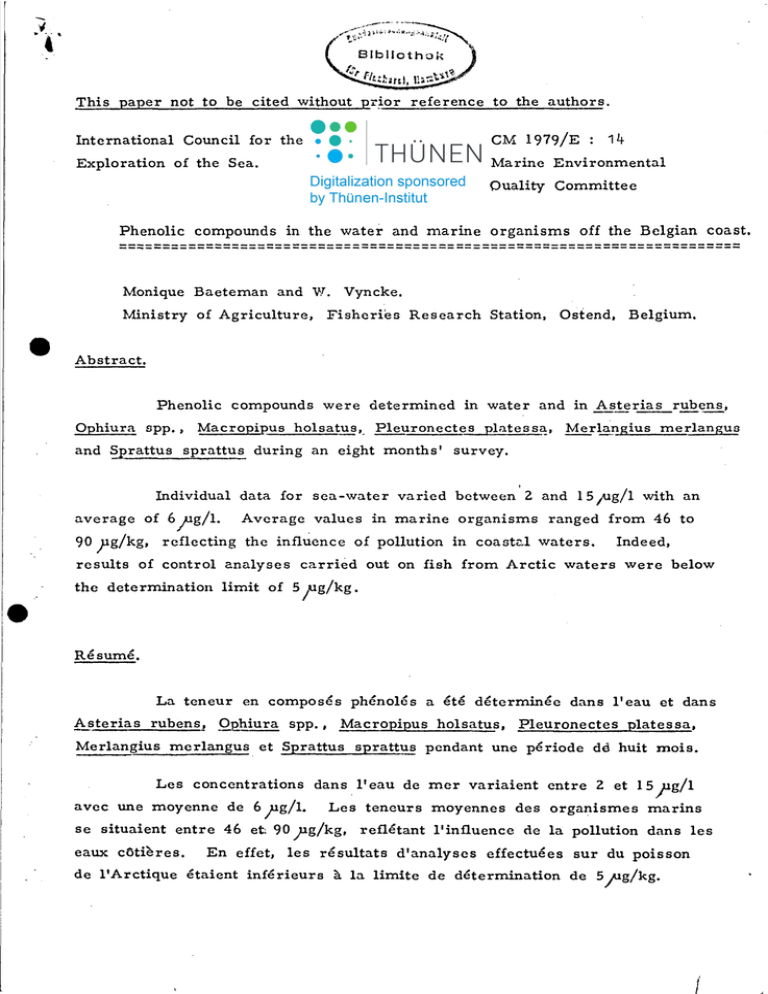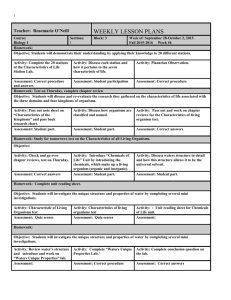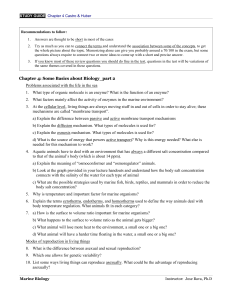.
advertisement

. ~- - l . This paper not to be cited without pl"~or reference to the authors. International Gouncil for the GM 1979/E : 14 Exploration of the Sea. Marine Environmental Ouality Gommittee Phenolic compounds in the water and marine organisms off the Bclgian coast. ==~=================================================== ================== Monique Baeteman and W. Vyncke. • Ministry of Agriculture. Fisheri(~s Research Station. Ostend. Belgium. Abstract. Phenolic compounds were determined in water and in Asterias Ophiura spp., Macropipus holsatus •. Pleuronectes plntess~, rube~. Merlangius merlangus and Sprattus sprattus during an eight months' survey. . Individual data for sea-water varied bctween 2 and 15.Jlg/l with an average of 6 j1g/1. Average values in marine organisms ranged from 46 to 90 jlg/kg, reflecting the infhience of pollution in coastal waters. Indeed, results of control analyses carrit~d out on fish from Arctic waters were below thc determination limit of 5 t-g/kg. Resume. La tcneur en composes phenoles a ete determinee dans l'eau et dans b-sterias rubens 1 Ophiura spp., Macropipus holsatus, Pleuronectes platessa, Merlangius merlangus. et Sprattus sprattus pendant une periode de huit Inois. Les conccntrations dans l'eau dc mcr variaient entre 2 et 15 )lg/l avcc une moyenne de 6 j1g/l. Les teneurs moyenncs des organismes marins Se situaient entre 46 et; 90 j1g/kg. reiletant l'influence de la pollution dans les eaux cotieres. En effet, les resultats d'analyscs effectuees sur du poisson de l'Arctique etaient inferieurs a la limite de determination de 5flg/kg. I 2. Int roduction. Phenolic compounds are found as contaminants in almost a11 surface waters, inc1uding marine coastal waters. Potential sources of these substance s inc1ude industrial waste water effiuents (16) and municipal sewage (9). In addition the natural decomposition of organic matter m~y give rise to phenolic metabolites (8). Phenolic substances were shown to be responsible for the tainting of fresh water fish fiesh and, at higher eoneentrations, may provoke a toxieologieal responee in eertain aquatic organisms (4) (15). LC~~ eentration The average lethal eon- of phenol was 21,5 mg/l for grey mullet (Mug'il saliens) (20) and 8,2 mgll for rainbow trout (Salmo gairdneri) (13). Gill and digestive traet epithelia of c1ams were damaged at eoneentrations of 1 mg/l for 24 h or longer (5). Data on sublethai effects of phQul are searee. Deereased numbers of erythrocytes, lower amounts of serum proteins, lesions in gills, degenerative ehanges in skin, intestines, musc1es and liver werd reeorded in several fresh water species (10) (15). Avoidanee reaetions of Hsh to phenols were also studied by several authors but controversial results were obtained (15). As industrial wastcs eontaining 1 t 5 • % phenols are diseharged re- gularly off the Belgian eoast (figure 1) a survey of the phenol eontent of the sea water and representative marine organisms was earried out. Materials and methods. - ~~~~l..e..s.: - water : water sampies were taken at 1 m from the bottom and kept untreated in iee. . ~':'.. They were analyzed within 24 h. - organisms six marine organisms eharaeteristie ior Belgian eoastal waters were taken (table 1). With the exception of plaiee and whiting, where only the musc1e tis sue was analyzed, whole animals were taken for the phenol determination. At least five organisms were taken to obtain one eombined sample. kept frozen at _30 0 C until analysis. The sampies were 3. The colorimetric 4-aminoantipyrine method as ouUined by APHA (I) was used with some modifications. With sea-water t treated with 1 m1 phosphoric acid 8 t 5 % 150 m1 sampies were and 5 ml copper II sulfate 10 steam-distilled into 10 ml of ammonium chloride solution 5 distillate was obtained. distillate. % % and until 500 ml The colorimetric reaction was carried out on this Measurement was made at 460 nm with a spectrophotometer Hach DR/EL 2 (Hach Chemical Company, Ames t lowa, U. S.A.) with long path attach ..... ment using a 5 cm (15 ml) chloroform layer. With marine organisms the same procedure was used taking 25 g of minced material. The results were expressed <lS the equivalent of phenol in j1g/1 or Recovery tests gave an average of 93 4,8 % with a standard deviation of %. The determination limit was calculated on the blanks according to the method of Gabriels (6) and was 5.J1g/kg for organisms and 1 )lg/l for water. - Proccdure. Sea-water and marine organisms were taken from two areas off the Belgian coast whilst carrying out a bimonthly physico-chemical and biological monitoring programme on sand extraction siteo (Western area) and dumping grounds for industrial wastes (Eastern area) (figure 1). Ten sampies of marine organisms were taken at random in each area during an eight months' period (september 1978-april 1979). Nine water sampies: were taken three times during the same period in each area on fixed locations (figura 1). 4. - Results. Table 1 - Phenolic compounds in marine organisms from Be1gian coastal waters ~g/kg) (a). Western area : Average (b) v (%) s. (n=10) Organism • _._wo I Eastern area Average (b) (n=lO) i v (%) s . Sea star (Asterias rubens) 51(2) 33,2 65 46(3) 29,0 63 Brittle star (Ophiura spp.) 85(2) 53,5 63 79(3) 73,1 92 76 35,4 ·17 59(2) 55,4 94 Plaice (Pleuronectes platessa) (O-I year) 74(1 ) 42,7 58 62 33,7 54 Whiting (Merlangius merlan~) (O-I year) 79 67, 1 85 59 39,0 I 66 67 63 34,8 ! 55 Swimming crab (Macr2.Qipus . holsatu~) I I I 90(1) I Sprat (Sprattus sprattus) I , 60,3 I I i , (a) s = standard deviation ; v = coefficient of variation. (b) number of analyses under the determination limit cf 5 yg/kg in brackets these concentrations were considered to be 0 for further ca1culations. The average results cf the three phenol determinations on water are reported in figure 1. Individual data varicd between 2 and 15 .J1g/l (Western areal and 2 and 13 yg/l (Eastern areal. Total averages for both areas were 6.;ug/l with standard deviations of respectively 3, 1 (W) and 2,4 (E). The difference bctwcen these two data was not significant (F-test). pooled standard deviLl.tion of 45 W<l.S The 2, 7 corresponding with a variation coefficient %. The content of phenolic compounds in marine organisms is reported in table 1. Highest reported value was 225 pg/kg in a sea star. Although average values were higher in the Western area, t-tests showed these differences not to be significant, undoubtedly due to the high standard deviations. Application of the Hartley test (7) showed these deviations not to be significantly different. 5. - Discussion. In the water, phenolic compounds could be detected in the whole coastal area under survey. The average value of 6.)le/l is higher than the value reported for SCil-water in general i. e. 1-3 )le/l (2) hut is 10w whon considering concentrations occurring in some inland surface waters. The values reported here are in accordance with previous Be1gb,n investigations carried out in 1971 -75 which showed thc phenol contcnt of the sea water to be lowcr than 13 )lg/l from a distance of 6 km from thc coast on wards (17). • As most harmful eHects on marine life are occurring only with concentrations in the mg/l region (4) (15) damage to living ressources of the sea is rather llOlikely. micro-organisms, It has moreover been shown that several groups of espedally Pseudomonas and Bacterium, are able to degrade phenol compounds thus preventing excessive accumulation in the water (3) (11) (14) (18) (19). It should also be mentioned in this rcspect that Hsh are able to dispose of phenol through biliary excretion from the liver, probably after detoxication by sulfate conjugation (12). The concentration of phcnolic compounds in thc marine organisms tested showed important variations. similar, Averagcs on the other hand were fairly situated mostly around 60-80.Jlg/kg. Although these values may be considered to be low, they neverthcless reneet the influence of pollution in coastal waters. Indced. results of control analyses earried out on redfish (Sebastes marinus) and eod (Gadus morhua) from Arctie waters were below the determination limit of 5.,J1g/kg. It should howevcr be strcssed that frequent organoleptie assessments of several fish spedes caught in Belgian coastal waters did not indicate thc prcsence of flavour-imparting substances in thc flesh. Finally, these investigations allowed to eonclude that the dumping of organic waste containine phenols in the area reported in figure 1 did not influencc significantly thc content of these compounds in the water or in thc organisms. Other sources apparently eontribute more to thc amounts found. It should be stressed that the concentrations mentioncd in this paper relatc to aminoantipyrine-reactivc substnnccs only. should be taken into account (1). Thc limitations of this methbd ,.....--------------------- - 6. Literature. (1) American Public Hcalth Assoeiation (1975) : Standard Methods for the Examination of Water and Wastewater, 14th Ed., Washington, D. C. p. 577. (2) Degens, E., Reuter, J. and Shaw, K. (1964) : Geochim. Cosmochim. Acta 28 (1) 45. (3) Errnolaev, K. and Mi~onov, O. (1975) : Mikrobiologiya 44, 928. (4) European Inland Fisheries Advisory Cornmission (1973) : Water Res. 1, 929. • (5) Fries, C. and Tripp, M. (1976) : Mar. (6) Gabriels, R. (1970) : Anal. Fish. Rev. 38 (10) 10. Chern. 42, 1439• (7) Hartley, H. (1950) : Biometrika 37, 308. (8) Hoak, R. (1962) : lnt. J. Air Water PoHut. ~, 521. (9) Hunter, J. (1971) : in : Organic Compounds in Aquatic Environment, S. Faust and J. Hunter (Ed.), Marcel Dekker, Inc., New York. (10) International Council for the Exploration of the Sea (1978) : On the Feasibility of Effets Monitoring, lCES, Cooperative Research Report No. 75, Copenhagen. (11) Kaplin, V., Semenchenho, L. and Ivanov, E. (1968) Gidrokhim. Mater. 46, 199. (12) Kobayashi, K., Akitake, H. and Kimura, S. (1976) BuH. Jap. Soc. Sei. Fish. 42, 45. (13) McLeay, D. (1976) : J. Fish. Res. Board Can. (14) Mikryakova, T. and Klajn, N. 33, 1303. (1975) : Tr. Inst. Biol. Vnutr. Vod (30), 130. (15) Mitrovic, V. (1972) : in : Marine Pollution and Sea Lire, M. Ruivo (Ed.), Fishing News (Books) Ltd, London. (16) Nernerow, N. (1971) : Theories and Practices of Industrial Waste Treat- ment, Addison - 'Wesley Pub!. (17) Nihoul, J'.' and Boelen, C. Comp., Reading, Mass., USA. (Ed.) (1975) : Niveawc de pollution du reSGafll..l hydrographique ct de Ia zone cotiere beiges - Projet Mer, Rapport Final, Vol. 11 C, Services du Premier Ministre, Bruxelles. (18) Polisois, G., Tessier, A., CampbeH, P. and Villeneuve, J. (1975) J. Fish. Res. Board Can. 32, 2125. (19) Thielemann, H. (19'75) : Acta Hydrochim. Hydrobiol. (20) Zambriborfhch, F. (1977) : Gidrobiol. 1, 191. Zh. U(2), 91. J Legend to Hg. 1. Western and Eastern sampling areas showing the average concentrations of phenolic compounds in the water (in flg/1). - . _._----~. . . . . . . . - - - - - - - - - - - - - - - - - - - - - - - - - - - - - - - - - ...:_,-J;..:.-....-..>..----.....-~..t---~- 1 . . ~ ,"." , . site waste \,. Zeebrugge \ ....-- #. "',' . .;---.. .:.- 'ur-" .. _ ... u,.~_..... , .10 --... ~_~_~.~. _ _ ~ .._._.__ .~.~. .__ ._ ......__. _ ..._,._ ... _.__ i --"'IIIIIIIIIl





